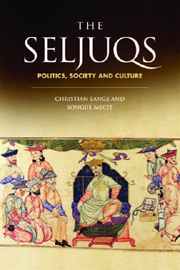Book contents
- Frontmatter
- Contents
- List of figures
- Acknowledgements
- List of abbreviations
- INTRODUCTION
- PART I POLITICS
- 1 THE ORIGINS OF THE SELJUQS
- 2 ASPECTS OF THE COURT OF THE GREAT SELJUQS
- 3 ‘SOVEREIGN AND PIOUS’: THE RELIGIOUS LIFE OF THE GREAT SELJUQ SULTANS
- 4 KINGSHIP AND IDEOLOGY UNDER THE RUM SELJUQS
- 5 SELJUQ LEGITIMACY IN ISLAMIC HISTORY
- PART II SOCIETY
- Part III CULTURE
- Index
4 - KINGSHIP AND IDEOLOGY UNDER THE RUM SELJUQS
from PART I - POLITICS
Published online by Cambridge University Press: 12 September 2012
- Frontmatter
- Contents
- List of figures
- Acknowledgements
- List of abbreviations
- INTRODUCTION
- PART I POLITICS
- 1 THE ORIGINS OF THE SELJUQS
- 2 ASPECTS OF THE COURT OF THE GREAT SELJUQS
- 3 ‘SOVEREIGN AND PIOUS’: THE RELIGIOUS LIFE OF THE GREAT SELJUQ SULTANS
- 4 KINGSHIP AND IDEOLOGY UNDER THE RUM SELJUQS
- 5 SELJUQ LEGITIMACY IN ISLAMIC HISTORY
- PART II SOCIETY
- Part III CULTURE
- Index
Summary
This chapter will give a short outline of the evolution of the official ideology of kingship of the Rum Seljuqs. It will be argued that the Rum Seljuq concept of legitimate kingship was formulated for the first time under the fifth Rum Seljuq ruler ʿIzz al-Dīn Kılıç Arslan II (r. 551–88/1156–92) and re-formulated and completed under his two grandsons ʿIzz al-Dīn Kay Kāwus I (r. 608–16/1211–20) and ʿAlaʾ al-Dīn Kay Qubādh I (r. 616–34/1220–37). Rum Seljuq ideology of kingship was thus formulated at a time when the new dynasty had been consolidated as an independent dynasty in Anatolia following the disintegration of the state of their Great Seljuq cousins and rivals. At the same time the ideology of kingship was formulated in order to defend their new-found status against Muslim rivals who appeared on the eastern borders of their realm, the atabegs of the Great Seljuq princes and commanders, as well as Turkish warlords not attached to the Great Seljuqs who founded principalities usurping the remains of the Great Seljuq empire in Iraq, northern Syria and upper Mesopotamia. Among these, Nūr al-Dīn Maḥmūd (r. 541–69/1147–74) the son of the Great Seljuq atabeg Zangi (r. 521–41/1127–46) and the former's Kurdish lieutenant and successor Saladin (r. 564–89/1169–93) were to become the main rivals of the Rum Seljuqs in the east.
The Rum Seljuq rulers did not commission treatises to elaborate their ideology and the source material for the Rum Seljuqs in general is far from rich.
- Type
- Chapter
- Information
- The SeljuqsPolitics, Society and Culture, pp. 63 - 78Publisher: Edinburgh University PressPrint publication year: 2011



